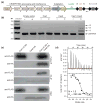Cas1-Cas2 complex formation mediates spacer acquisition during CRISPR-Cas adaptive immunity
- PMID: 24793649
- PMCID: PMC4075942
- DOI: 10.1038/nsmb.2820
Cas1-Cas2 complex formation mediates spacer acquisition during CRISPR-Cas adaptive immunity
Abstract
The initial stage of CRISPR-Cas immunity involves the integration of foreign DNA spacer segments into the host genomic CRISPR locus. The nucleases Cas1 and Cas2 are the only proteins conserved among all CRISPR-Cas systems, yet the molecular functions of these proteins during immunity are unknown. Here we show that Cas1 and Cas2 from Escherichia coli form a stable complex that is essential for spacer acquisition and determine the 2.3-Å-resolution crystal structure of the Cas1-Cas2 complex. Mutations that perturb Cas1-Cas2 complex formation disrupt CRISPR DNA recognition and spacer acquisition in vivo. Active site mutants of Cas2, unlike those of Cas1, can still acquire new spacers, thus indicating a nonenzymatic role of Cas2 during immunity. These results reveal the universal roles of Cas1 and Cas2 and suggest a mechanism by which Cas1-Cas2 complexes specify sites of CRISPR spacer integration.
Figures




References
-
- Sorek R, Lawrence CM, Wiedenheft B. CRISPR-mediated adaptive immune systems in bacteria and archaea. Annu Rev Biochem. 2013;82:237–66. - PubMed
-
- Mojica FJ, Diez-Villasenor C, Garcia-Martinez J, Soria E. Intervening sequences of regularly spaced prokaryotic repeats derive from foreign genetic elements. J Mol Evol. 2005;60:174–82. - PubMed
-
- Bolotin A, Quinquis B, Sorokin A, Ehrlich SD. Clustered regularly interspaced short palindrome repeats (CRISPRs) have spacers of extrachromosomal origin. Microbiology. 2005;151:2551–61. - PubMed
-
- Barrangou R, et al. CRISPR provides acquired resistance against viruses in prokaryotes. Science. 2007;315:1709–12. - PubMed
Publication types
MeSH terms
Substances
Associated data
- Actions
Grants and funding
LinkOut - more resources
Full Text Sources
Other Literature Sources
Molecular Biology Databases
Research Materials

